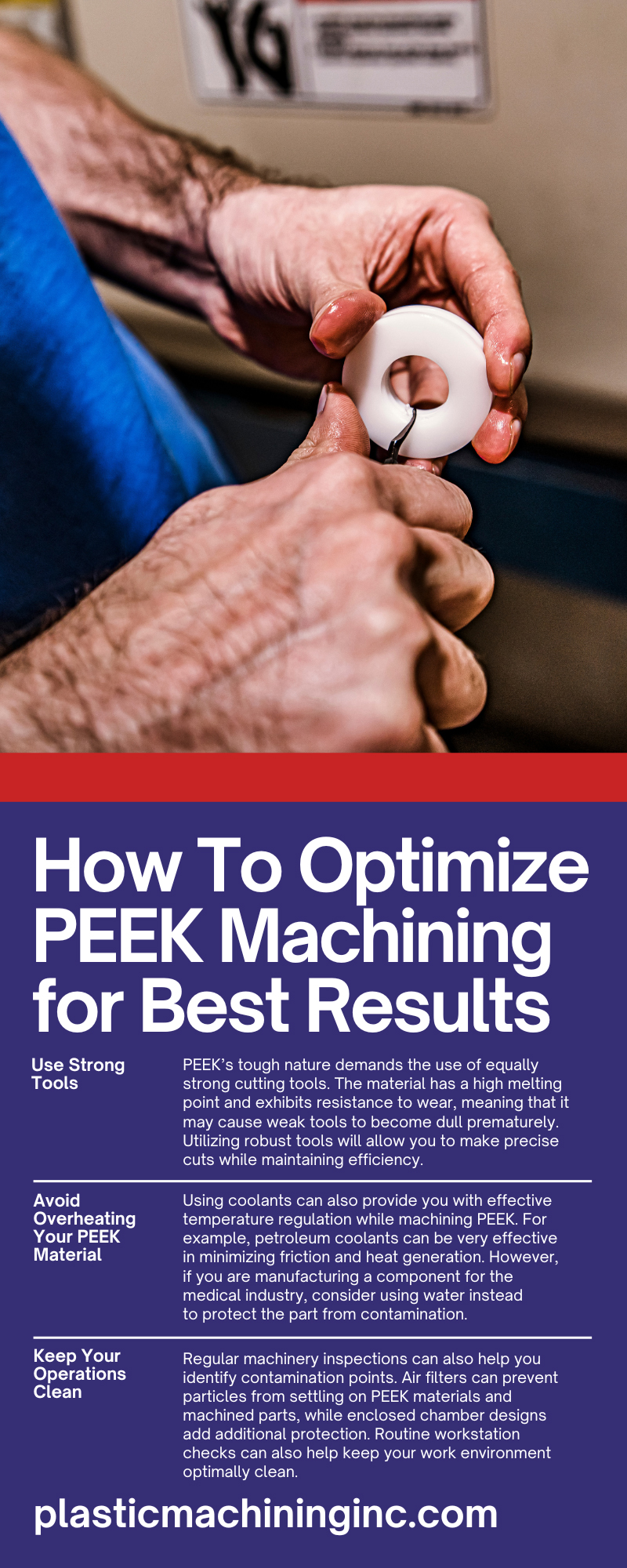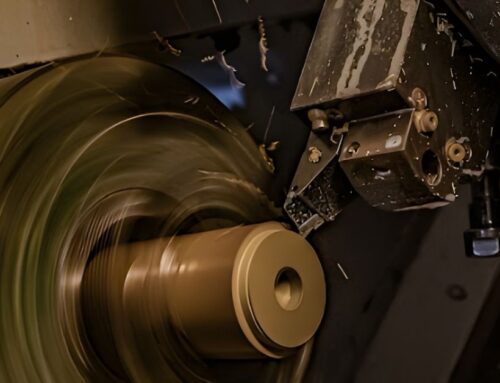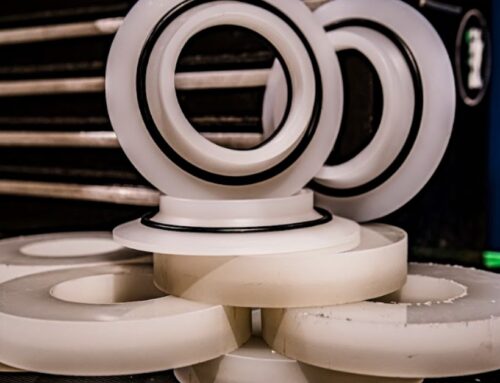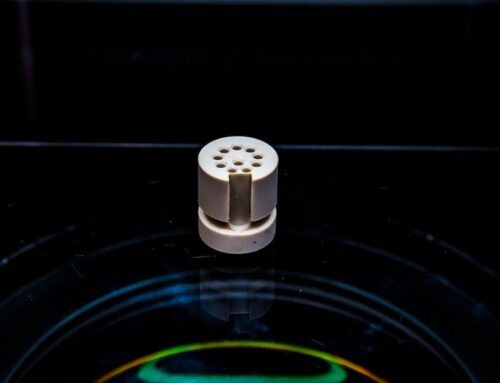Polyetheretherketone plastic, commonly referred to as PEEK, is useful in multiple sectors, including aerospace, automotive, and oil and gas. Its high-performance properties—including thermal stability, wear resistance, and chemical resilience—have made it indispensable in various modern industries.
However, maintaining the integrity of PEEK during machining requires the use of specialized techniques. Knowing how to effectively machine PEEK will prevent you from compromising the material’s integrity and allow you to enjoy its benefits. Read on to learn some tips on how to optimize PEEK machining for the best results.
Heat Treat the Plastic Ahead of Time
One important step in PEEK machining is to heat treat the material before you begin the machining process. PEEK can develop internal stresses during the material’s manufacturing process, which may cause it to experience distortions during machining. However, annealing PEEK can reduce this risk significantly.
When you heat treat it, you will need to warm the PEEK to a certain temperature and let it stay at that level for a certain amount of time. Allowing the material to cool afterward will complete the treatment process and prepare it for subsequent machining.
However, some cases may require you to anneal the PEEK more than once throughout the machining process. But, in the end, this thermal preparation enhances the consistency, reliability, and lifespan of your final parts.
Use Strong Tools
PEEK’s tough nature demands the use of equally strong cutting tools. The material has a high melting point and exhibits resistance to wear, meaning that it may cause weak tools to become dull prematurely. Utilizing robust tools will allow you to make precise cuts while maintaining efficiency.
For example, consider using carbide and diamond-coated tools for machining PEEK. These materials retain sharpness for a longer amount of time even after they have tackled multiple surfaces. They will effectively resist the heat generated from friction.
You should also avoid overlooking the importance of tool geometry. Use tools with rake angles optimized for plastics and milling speeds tailored for thermoplastics. These will help enhance the quality of your results. In addition, take great care to follow tool replacement schedules, since these will allow you to maintain their consistency. Otherwise, you may experience inaccuracies that compromise your intended design.
Avoid Overheating Your PEEK Material
Temperature management is also important in the PEEK machining process. Overheating can alter the material’s structural properties, leading to deformations that limit its usability. Understanding how to manage temperatures during machining processes ensures material precision and prevents unnecessary waste.
Machining PEEK requires a balance between feed rates and cutting speeds. Going too fast can raise the cutting zone’s temperature, potentially compromising the part’s integrity. Slower, controlled feeds reduce the risk of imperfections such as melting or poor surface finishes.
Using coolants can also provide you with effective temperature regulation while machining PEEK. For example, petroleum coolants can be very effective in minimizing friction and heat generation. However, if you are manufacturing a component for the medical industry, consider using water instead to protect the part from contamination.
Keep Your Operations Clean
Remember to maintain cleanliness when machining PEEK. Particles or residue adhere quickly to PEEK surfaces, altering the effectiveness of machining operations and impacting component performance. Maintaining cleanliness from preparation to completion yields smoother, flawless parts.
Ensure you use clean tools and work surfaces throughout the process. Standard cleaning agents or alcohol can help remove oil or dirt from tools without harming them.
Regular machinery inspections can also help you identify contamination points. Air filters can prevent particles from settling on PEEK materials and machined parts, while enclosed chamber designs add additional protection. Routine workstation checks can also help keep your work environment optimally clean.
Make sure to be careful when handling the PEEK material throughout the process; otherwise, you may contaminate the plastic. Always wear clean gloves when holding the material, and store it in protective containers when you have finished your work. That way, you can ensure you provide your end user with a safe, sanitary product.
It is also wise to wash PEEK components with lukewarm deionized water after the machining process. This helps remove residual coolant or debris. A final cleaning prevents elements from affecting operational performance and extends product longevity.
Ensure Your Machines Have the Proper Machining Parameters
Another important tip for optimizing PEEK machining for the best results is to ensure your machines have the proper parameters. For example, when it comes to your milling operations, choosing the correct feed rate and spindle speed is critical to avoid tool wear and material damage.
In addition, operate your carbide tools with low to moderate cutting speeds and light depths of cut. This will help maintain minimal heat buildup and prevent thermal degradation of the material.
Maintaining stable cutting parameters is also essential for producing clean, precise cuts during turning and drilling. For turning, employ sharp, uncoated carbide inserts with moderate cutting depths and speeds to efficiently machine PEEK while maintaining surface integrity.
Using coolant-fed carbide drills can also help disperse heat and prevent chip buildup, ensuring consistent hole quality. Carefully monitoring tool wear and adjusting parameters accordingly will further enhance your machining efficiency, while minimizing costs and downtime due to tool failure or defects.
Anneal the Material Once More Afterward
Although you annealed the PEEK at the start of the machining process, it can be helpful to do it again afterward. Machining often reintroduces stress into polymer materials. These stresses can lead to material failure over time unless you address them.
Post-machining annealing reduces internal stress and restores the material’s performance characteristics. Incorporating this process ensures sustained reliability for critical applications, such as those in the aerospace sector, where failure is not an option.
When engineers process PEEK with precision and care, exceptional results follow. You can obtain high-quality PEEK components with the help of Plastic Machining Inc. We have extensive experience delivering parts that meet clients’ needs in the aerospace, medical, and semiconductor sectors. Contact us today so you can start experiencing the benefits of PEEK components in your operations.






